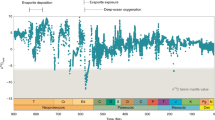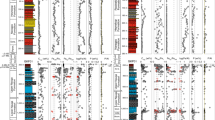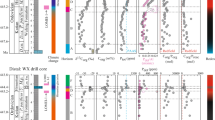Abstract
The global carbon and sulphur cycles are central to our understanding of the Earth’s history, because changes in the partitioning between the reduced and oxidized reservoirs of these elements are the primary control on atmospheric oxygen concentrations. In modern marine sediments, the burial rates of reduced carbon and sulphur are positively coupled, but high-resolution isotope records indicate that these rates were inversely related during the Early Cretaceous period1. This inverse relationship is difficult to reconcile with our understanding of the processes that control organic matter remineralization and pyrite burial. Here we show that the inverse correlation can be explained by the deposition of evaporites during the opening of the South Atlantic Ocean basin. Evaporite deposition can alter the chemical composition of sea water2,3, which can in turn affect the ability of sulphate-reducing bacteria to remineralize organic matter and mediate pyrite burial. We use a reaction–transport model to quantify these effects, and the resulting changes in the burial rates of carbon and sulphur, during the Early Cretaceous period. Our results indicate that deposition of the South Atlantic evaporites removed enough sulphate from the ocean temporarily to reduce biologically mediated pyrite burial and organic matter remineralization by up to fifty per cent, thus explaining the inverse relationship between the burial rates of reduced carbon and sulphur during this interval. Furthermore, our findings suggest that the effect of changing seawater sulphate concentrations on the marine subsurface biosphere may be the key to understanding other large-scale perturbations of the global carbon and sulphur cycles.
This is a preview of subscription content, access via your institution
Access options
Subscribe to this journal
Receive 51 print issues and online access
$199.00 per year
only $3.90 per issue
Buy this article
- Purchase on Springer Link
- Instant access to full article PDF
Prices may be subject to local taxes which are calculated during checkout




Similar content being viewed by others
References
Paytan, A., Kastner, M., Campbell, D. & Thiemens, M. H. Seawater sulfur isotope fluctuations in the Cretaceous. Science 304, 1663–1665 (2004)
Arthur, M. A. in Climate in Earth History 55–67 (National Academy Press, Washington DC, 1982)
Holser, W. T., Schidlowski, M., Mackenzie, F. T. & Maynard, J. B. in Chemical Cycles in the Evolution of the Earth 105–174 (John Wiley & Sons, New York, 1988)
Berner, R. A. & Raiswell, R. Burial of organic carbon and pyrite sulfur in sediments over phanerozoic time: a new theory. Geochim. Cosmochim. Acta 47, 855–862 (1983)
Wortmann, U. G., Bernasconi, S. M. & Böttcher, M. E. Hypersulfidic deep biosphere indicates extreme sulfur isotope fractionation during single step microbial sulfate reduction. Geology 29, 647–650 (2001)
Brunner, B. & Bernasconi, S. M. A revised isotope fractionation model for dissimilatory sulfate reduction in sulfate reducing bacteria. Geochim. Cosmochim. Acta 69, 4759–4771 (2005)
Deines, P. in Handbook of Environmental Geochemistry (eds Fritz, P. & Fontes, J. C.) Vol. 1 239–406 (Elsevier, New York, 1980)
O'Leary, M. H. Carbon isotope fractionation in plants. Phytochemistry 20, 553–567 (1981)
Herrle, J. O., Kößler, P., Friedrich, O., Erlenkeuser, H. & Hemleben, C. High-resolution carbon isotope records of the Aptian to Lower Albian from SE France and the Mazagan Plateau (DSDP Site 545): a stratigraphic tool for paleoceanographic and paleobiologic reconstruction. Earth Planet. Sci. Lett. 218, 149–161 (2004)
Erba, E. et al. Integrated stratigraphy of the Cismon Apticore (Southern Alps, Italy): A ‘reference section’ for the Hautrivian-Aptian interval at low latitudes. J. Foraminiferal Res. 29, 371–391 (1999)
Raiswell, R. & Canfield, D. E. Sources of iron for pyrite formation in marine sediments. Am. J. Sci. 298, 219–245 (1988)
Ryan, W. B. F. & Cita, M. B. Ignorance concerning episodes of ocean-wide stagnation. Mar. Geol. 23, 197–215 (1977)
Schlanger, S. O. & Jenkyns, H. C. Cretaceous oceanic anoxic events: causes and consequences. Geol. Mijnbouw 55, 179–184 (1976)
Burke, K. & Şengör, C. Ten metre global sea-level change associated with South Atlantic Aptian salt deposition. Mar. Geol. 83, 309–312 (1988)
Southam, J. R. & Hay, W. W. in The Oceanic Lithosphere (ed. Emiliani, E.) Vol. 7 of The Sea 1617–1684 (Wiley-Interscience, New York, 1981)
Zharkov, M. A. History of Paleozoic Salt Accumulation 1–308 (Springer, New York, 1981)
Rhonov, A. B. The earth’s sedimentary shell (quantitative patterns of its structure, compositions, and evolution). Int. Geol. Rev. 24, 1365–1388 (1982)
Lowenstein, T. K., Hardie, L. A., Timofeef, M. N. & Demicco, R. V. Secular variation in seawater chemistry and the origin of calcium chloride basinal brines. Geology 31, 857–860 (2003)
Arthur, M. A. & Premoli Silva, I. in Nature and Origin of Cretaceous Carbon-Rich Facies (eds Schlanger, S. O. & Cita, M. B.) 7–54 (Academic, San Diego, California, 1982)
Wortmann, U. G., Herrle, J. O. & Weissert, H. Altered carbon cycling and coupled changes in Early Cretaceous weathering patterns: Evidence from integrated carbon isotope and sandstone records of the western Tethys. Earth Planet. Sci. Lett. 220, 69–82 (2004)
Weissert, H. & Erba, E. Volcanism, CO2 and paleoclimate: A Late Jurassic-Early Cretaceous carbon and oxygen isotope record. J. Geol. Soc. 161, 695–702 (2004)
Bjerrum, C. J., Bendtsen, J. & Legarth, J. J. F. Modeling organic carbon burial during sea level rise with reference to the Cretaceous. Geochem. Geophys. Geosyst. 7 Q05008 doi: 10.1029/2005GC001032 (2006)
Wortmann, U. G., Zacher, W. & Hesse, R. Major-element data from cyclic black shales and their paleoceanographic implications for the early Cretaceous deep western Tethys. Paleoceanography 14, 525–541 (1999)
Berner, R. A. A model for calcium, magnesium and sulfate in seawater over phanerozoic time. Am. J. Sci. 304, 438–453 (2004)
Holland, H. D. Sea level, sediments and the composition of seawater. Am. J. Sci. 305, 220–239 (2005)
Chernyavsky, B. & Wortmann, U. G. REMAP: A reaction transport model for isotope ratio calculations in porous media. Geochem. Geophys. Geosyst. 8 Q02009 doi: 10.1029/2006GC001442 (2006)
Leckie, R. M., Bralower, T. J. & Cashman, R. Oceanic anoxic events and plankton evolution: Biotic response to tectonic forcing during the mid-Cretaceous. Paleoceanography 17 1–29 doi: 10.1029/2001PA000623 (2002)
Parkes, R. J. et al. Deep sub-seafloor prokaryotes stimulated at interfaces over geological time. Nature 436, 390–394 (2004)
Acknowledgements
We thank M. Kastner, B. Hay, H. Weissert, N. Andersen, A. J. M. Stams and B. Brunner for discussions. J. Bollmann, E.T.C. Spooner, J. Walker, L. Lee, J. Yap and C. Banks provided helpful comments on an earlier version of this manuscript. We gratefully acknowledge the comments of M. Arthur. M. Gorton, H. Li and C. Greyrobe provided assistance in the laboratory. C. Marra participated in this study as part of a University of Toronto mentorship program for gifted high school students. This work was supported by the Natural Sciences and Engineering Research Council of Canada (NSERC).
Author information
Authors and Affiliations
Corresponding author
Ethics declarations
Competing interests
Reprints and permissions information is available at www.nature.com/reprints. The authors declare no competing financial interests.
Supplementary information
Supplementary Methods
This file contains Supplementary Methods and additional references. (PDF 214 kb)
Rights and permissions
About this article
Cite this article
Wortmann, U., Chernyavsky, B. Effect of evaporite deposition on Early Cretaceous carbon and sulphur cycling. Nature 446, 654–656 (2007). https://doi.org/10.1038/nature05693
Received:
Accepted:
Issue Date:
DOI: https://doi.org/10.1038/nature05693
This article is cited by
-
Iron and Trace Metals in Microbial Mats and Underlying Sediments: Results From Guerrero Negro Saltern, Baja California Sur, Mexico
Aquatic Geochemistry (2011)
-
Volcanic triggering of a biogeochemical cascade during Oceanic Anoxic Event 2
Nature Geoscience (2010)
-
Sulphate-sensitive seas
Nature Geoscience (2010)
-
Effect of nutrient availability on marine origination rates throughout the Phanerozoic eon
Nature Geoscience (2010)
Comments
By submitting a comment you agree to abide by our Terms and Community Guidelines. If you find something abusive or that does not comply with our terms or guidelines please flag it as inappropriate.



